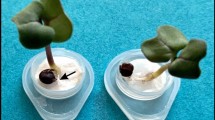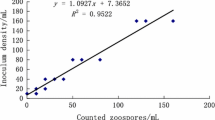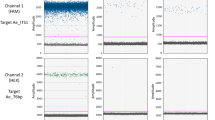Abstract
Resting spores of Plasmodiophora brassicae, the causative agent of clubroot in canola (Brassica napus) and other members of the Brassicaceae, can survive in soil for many years. Information on their vertical distribution in the soil profile is required to assess the efficacy of control measures and strategies for management of infested soil, for instance in road and pipeline construction. Vertical soil cores from the soil surface to 53-cm depth were collected from four naturally infested fields, one in Alberta and three in Ontario, and lateral cores, from the side of a trench, were collected at regular intervals down to 1-m depth at two infested fields in Alberta and one in Ontario. Genomic DNA of P. brassicae was assessed using quantitative polymerase chain reaction (qPCR) assays that included a competitive internal positive control to correct for inhibition. Genomic DNA of P. brassicae was detected to 1-m depth at one site, and moderate levels (up to 105 spores g −1) of resting spores were detected below the plow layer at several sites. The concentration of resting spores was not uniform, vertically or horizontally, throughout the soil at any site. Results indicate that resting spores move downwards in the soil profile over time.


Similar content being viewed by others
References
Al-Daoud, F., Gossen, B. D., Robson, J., & McDonald, M. R. (2016). Propidium monoazide improves quantification of viable resting spores of Plasmodiophora brassicae with qPCR. Plant Disease. doi:10.1094/PDIS-05-16-0715-RE.
Bilodeau, G. J. (2011). Quantitative polymerase chain reaction for the detection of organisms in soil. CAB Reviews: Perspectives in Agriculture, Veterinary Science, Nutrition and Natural Resources, 6(014), 1–14.
Cranmer, T. (2015). Vertical distribution of Plasmodiophora brassicae resting spores in soil and the effect of weather conditions on clubroot development. M.Sc. Thesis, Guelph: University of Guelph.
Deora, A., Gossen, B. D., Amirsadeghi, S., & McDonald, M. R. (2015). A multiplex qPCR assay for detection and quantification of Plasmodiophora brassicae in soil. Plant Disease, 99, 1002–1009.
Dhingra, O. D., & Sinclair, J. B. (1985). Detection and estimation of inoculum. In Basic plant pathology methods (pp. 92–93). Boca Raton: CRC Press.
Gossen, B. D., Adhikari, K. K. C., & McDonald, M. R. (2012). Effects of temperature on infection and subsequent development of clubroot under controlled conditions. Plant Pathology, 61, 593–599.
Gossen, B. D., Strelkov, S. E., Manolii, V. P., Cao, T., Hwang, S. F., Peng, G., & McDonald, M. R. (2015). Spread of clubroot on canola in Canada, 2003–2014. Old pathogen, new home. Canadian Journal of Plant Pathology, 37, 403–413.
Hwang, S. F., Cao, T., Xiao, Q., Ahmed, H. U., Manolii, V. P., Turnbull, G. D., Gossen, B. D., Peng, G., & Strelkov, S. E. (2012). Effects of fungicide, seeding date and seedling age on clubroot severity, seedling emergence and yield of canola. Canadian Journal of Plant Science, 92, 1175–1186.
Hwang, S. F., Howard, R. J., Strelkov, S. E., Gossen, B. D., & Peng, G. (2014). Management of clubroot (Plasmodiophora brassicae) on canola (Brassica napus) in western Canada. Canadian Journal of Plant Pathology, 36, 49–65.
Hwang, S. F., Ahmed, H. U., Zhou, Q., Turnbull, G. D., Strelkov, S. E., Gossen, B. D., & Peng, G. (2015). Effect of host and non-host crops on Plasmodiophora brassicae resting spore concentrations and clubroot of canola. Plant Pathology, 64, 1198–1206.
Kim, C. H., Cho, W. D., & Kim, H. M. (2000). Distribution of Plasmodiophora brassicae causing clubroot disease of Chinese cabbage in soil. Research in Plant Disease, 6, 27–33.
MacFarlane, I. (1970). Germination of resting spores of Plasmodiophora brassicae. Transactions of the British Mycological Society, 55, 97–112.
Natsch, A., Keel, C., Pfirter, H. A., Haas, D., & Defagoi, G. (1994). Contribution of the global regulator gene gacA to persistence and dissemination of Pseudomonas fluorescens biocontrol strain CHA0 introduced into soil microcosms. Applied and Environmental Microbiology, 60, 2553–2560.
Okazaki, M., Sugita, T., Shimizu, M., Ohode, Y., Iwamoto, K., deVrind Jong, E. W., deVrind, J. P. M., & Corstjens, P. L. A. M. (1997). Partial purification and characterization of manganese-oxidizing factors of Pseudomonas fluorescens GB-1. Applied and Environmental Microbiology, 63, 4793–4799.
Peng, G., Pageau, D., Strelkov, S. E., Gossen, B. D., Hwang, S. E., & Lahlali, R. (2015). A > 2-year rotation reduces Plasmodiophora brassicae resting spores in soil and the impact of clubroot on canola. European Journal of Agronomy, 70, 78–84.
Smith, M. S., Thomas, G. W., White, R. E., & Ritonga, D. (1985). Transport of Escherichia coli through intact and disturbed soil columns. Journal of Environmental Quality, 14, 87–91.
Wallenhammar, A. C. (1996). Prevalence of Plasmodiophora brassicae in a spring oilseed rape growing area in Central Sweden and factors influencing soil infestation levels. Plant Pathology, 45, 710–719.
Wallenhammar, A. C., Almquist, C., Soderstrom, M., & Jonsson, A. (2011). In-field distribution of Plasmodiphora brassicae measured using real-tiome PCR. Plant Pathology, 61, 16–28.
Williams, P. H. (1966). A system for the determination of races of Plasmodiophora brassicae that infect cabbage and rutabaga. Phytopathology, 56, 624–626.
Workneh, F., Yang, X. B., & Tylka, G. L. (1998). Effect of tillage practices on vertical distribution of Phytophthora sojae. Plant Disease, 82, 1258–1263.
Acknowledgements
The authors thank C. Grainger for technical assistance with qPCR, J. Dalton and K. Delfosse for assistance in the lab and field, and D. Burke, N. Rauhala and G.D. Turnbull for collection of soil samples in Alberta. Financial support was provided by the Agriculture Development Fund of the province of Saskatchewan, and the Canola Science Cluster of Agriculture and Agri-Food Canada and the Canola Council of Canada.
Author information
Authors and Affiliations
Corresponding author
Rights and permissions
About this article
Cite this article
Cranmer, T.J., Al-Daoud, F., Gossen, B.D. et al. Vertical distribution of resting spores of Plasmodiophora brassicae in soil. Eur J Plant Pathol 149, 435–442 (2017). https://doi.org/10.1007/s10658-017-1193-x
Accepted:
Published:
Issue Date:
DOI: https://doi.org/10.1007/s10658-017-1193-x




